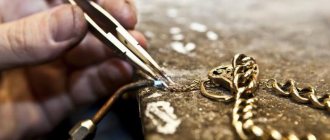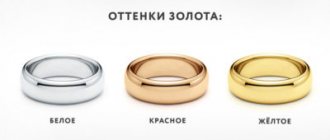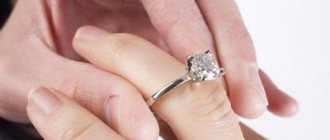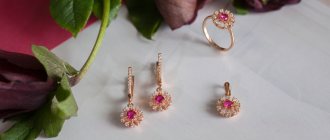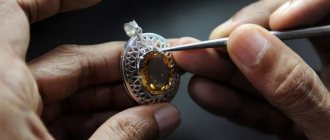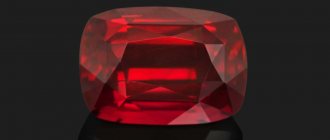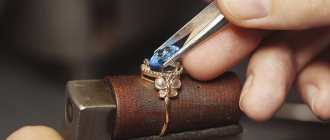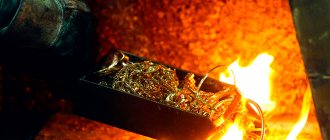- Which bracelets can be shortened?
When your favorite bracelet begins to dangle or squeeze your hand, the joy of the purchase is instantly replaced by a feeling of discomfort and nervousness about how not to lose it. There is only one way out - go to a jewelry workshop or try to solve the problem yourself. But here you cannot do without special knowledge and skills.
YuK has collected the most effective ways to lengthen/shorten a bracelet without losing quality, and how to do it yourself at home.
Options for damage to jewelry
What even happens to a ring, pendant, brooch, earrings or bracelet? The chain may break, the ring may crack, a chip or crack may appear on the pendant, and a stone may fall out of the earring. Almost any problem can and should be eliminated. But sometimes you still need to clean and polish the gold jewelry, enlarge or reduce the ring, fix the lock... You can’t count everything, and factory defects are not uncommon.
You need to understand that repairing gold products is a responsible and complex undertaking. As a rule, it can be performed by a master who has the appropriate equipment. How often do accessories break? Everything is simple here: the more often we wear it, the faster the precious item becomes unusable.
A long gold chain can be snagged and broken. In addition, the chains increase over time. This does not mean that they become larger and heavier - they simply become thinner and seem to stretch. Jewelers say that a chain measuring 50 cm can lengthen by 6 cm over time.
What can you repair yourself?
Without gold, some girls simply do not leave the house. Be sure to wear rings, bracelets, and chains. If the beads are torn, it is easy to fix the damage at home. You need a strong thread or fishing line, onto which we carefully string the beads, observing the original order, so as not to disturb the color or size range.
Another popular failure: “the gold chain is broken.” This problem can also be helped by repairing the gold thing with your own hands. But there are several specific points that need to be taken into account when repairing. You can repair a gold chain yourself, but you will need:
- special gold solder (it could just be a piece of an old earring or other chain, but only gold);
- a thin steel needle (an ordinary sewing needle, which should easily pass through a chain link);
- small vice;
- tweezers;
- asbestos sheet;
- small wire cutters;
- gas-burner;
- blowpipe;
- needle file
The technology is as follows: we put an asbestos sheet on the table and make repairs on it - so that there is no fire. We clamp the gold chain in a vise and use a needle to connect the links. We heat the place where the parts of the chain come into contact with a burner, directing the flame through a blowpipe. And we do this until the gold begins to glow. Place a small piece of gold (solder) into the soldering area with tweezers. The temperature will cause it to melt and spread over the joint. Next, let it cool and carefully remove the excess with nippers and a file. The chain is ready for use.
Repairing a gold item yourself cannot always restore it to its former appearance and beauty. In addition, if you are not confident in your skills and are not very dexterous with a soldering iron or a needle file (the work is delicate), then the direct route to the workshops.
Stages of soldering a gold chain at home
- Solder preparation. If you don’t have special solder for gold, you can create it from scrap materials at home. To do this, you need to prepare a crucible for melting metals, a small amount of gold, silver and copper. As well as pharmacy scales and a mold for melting solder. The recipe itself is as follows: for 585 parts of gold, take 115 parts of silver and 185 parts of copper.
- Preparing the chain for soldering. It is necessary to secure the product in a vice or other clamp so that the damaged area is visible. The product must take its original shape. That is, the thread must be straight.
- Preparation for soldering. It is necessary to boil the solder and gold jewelry. Under the influence of high temperatures, gold will be covered with a special protective layer.
- Adjusting the flame and soldering itself. Before starting to create a seam, it is worth adjusting the burning intensity. Then heat the gold evenly at the joint. When the chain reaches the desired temperature at the break point, take solder and make a neat seam.
- Grinding and processing of the seam. If, after “gluing” the links, a large seam has formed that protrudes above the surface of the chain, it must be sanded. And then treat it with a special napkin to give the product shine.
Important! You not only need to understand how to solder a gold chain at home, but also be able to handle soldering equipment. And also for miniature products with small links, there is another, more subtle soldering technology.
What gold repair services do jewelers provide?
The delicate and complex specifics of working with stone and gold require special equipment and the experience of the craftsman. The main condition for gold repair is a high-quality update of the product without its radical transformation. The most common service in the list of types of gold jewelry repairs is soldering.
Causes of chain wear
If not all, then the vast majority of women have precious gold woven threads, and men are no strangers to the love of the yellow metal. The chain is a thin and elegant thing, and therefore becomes thinner quite quickly. Moreover, if there is additional weight on it in the form of a cross, pendant, horseshoe, then the wear process accelerates. For example, an armored gold chain without a pendant can last 15 years, but any addition weighing about 2 grams will reduce the service life by three times, and repairs will be required. Another point that needs to be taken into account: worn chains cannot be completely restored - the master will simply extend their life for a short time.
The following signs indicate chain wear.
- Its lengthening.
- Tears near the lock. The wear on the chain is greatest on both sides of the lock. This is explained by the fact that the mount itself is heavier and wears out gold links faster. Usually the master removes areas on both sides of the lock (about 1–2 cm on each side).
- "Stepping". With a slight tension on the chain, straight lines and “steps” appear. This happens when the thinned (erased) parts seem to fit into each other and become fixed.
Chain breaks can also be mechanical. For example, kids often tear their mother’s necklaces and beads. Another common way to break is by trying to untangle chains that have curled up into a ball. This threat can be avoided with proper storage.
Soldering and welding in gold repair
The most common technology for eliminating trouble is soldering with an open flame torch. In this case, special equipment and professional reagents and solder are used. Moreover, this solder is made of gold of a standard no lower than the product itself. Repairing complex gold items, such as certain chain weaves, should still be done using contact soldering or laser welding. In addition, if necessary, the master will restore the galvanic coating. All repair work is completed by an ultrasonic cleaner, which will clean the chain of both accumulated dirt and the remnants of special polishing pastes.
But with the help of soldering and welding, not only chains are repaired. This is generally one of the main types of repair work in jewelry. For example, soldering eliminates such defects.
- Worn lugs and cross rings on pendants and drop earrings. But here soldering is possible with minor damage, otherwise it is better to replace these parts.
- Worn pins in gold glider bracelets or necklaces. A pin is a part in a structure that serves to connect two parts (gliders) of a gold product. In such cases, experts recommend replacing all the pins with new ones. This is due to the characteristics of bracelets or necklaces, which consist of glider links connected in different ways. The most difficult thing is to replace the pins hidden inside; they (or their remains) have to be drilled out when repairing a gold item.
- Cracks that usually appear due to manufacturing defects (possible problems in casting or poor quality assembly). This defect usually appears when the metal is fatigued or under additional loads.
Repairing gold jewelry with inclusions or coatings requires even more professionalism and experience. After all, inserts, that is, any cut stone or plate made of amber, turquoise, pearls, as well as enamel, cannot withstand high temperatures, as well as galvanizing or oxidation. In such cases, the inserts are isolated, secured, and if this is not possible, then replaced.
The coatings additionally have to be restored, and sometimes the enamels have to be reapplied. In these cases, it is certainly better to use high-precision laser welding or contact soldering rather than an open flame of a torch.
Repair of enamel jewelry
This is one of the oldest techniques in jewelry making. The first enamel accessories - rings found in burials in Cyprus - are dated by archaeologists to the 12th century BC. And, probably, one of the most beautiful techniques, so it is not surprising that recently more and more enamel items have begun to appear. But repairing them is very difficult. In addition to normal wear and tear and chips with cracks, abrasion of the enamel is added. Jewelers have to tinker with its restoration.
The repair process takes place in several stages. First, the enamel is ground to a powder. Then it is mixed with high purity gold and sent to the furnace. After melting, it is cooled a little - at the same time it thickens - and with thin tools it is distributed into the cells of the jewelry - ring, bracelet, earrings. And again they burn for about 2-3 minutes at one and a half thousand degrees. This process of filling the cells is repeated several times until the enamel fills them to the brim. The final stage is polishing the product.
Restoring the frame and inserting a fallen stone
Jewelers call an insert any cut precious stone or plate of an ornamental stone. There are a lot of reasons for the insertion stone to fall out, as well as methods of fastening during repairs, so there is no point in listing everything, let’s name the main ones.
- The leader among them is a manufacturing defect. The stone was simply poorly secured during the production of the jewelry, and it fell out. Replacing it is not difficult, especially if it is not lost and is delivered safely to a jewelry workshop for repair.
- It is worse if the stone is broken or knocked out, since in this case both the insert and the frame (caste) often suffer. If you're lucky, you can repair both the cast and secure the stone; in the worst case, you'll need to restore the frame and replace the insert. Such repairs take time and are not cheap.
- When parts of the cast wear out, welding is usually used. The cost of such repairs is often comparable to making a new frame, so it's worth considering. But if a family or especially valuable piece of jewelry is damaged, then they no longer think about the cost.
- Sometimes repairs involve replacing the stone. This is usually done in case of scuffs or any damage (cracks, chips). The price of such a service depends on the cost of the insert, that is, setting zircon is cheaper than repairing stones of the first group (sapphires, rubies, emeralds) or diamonds.
There are a huge variety of methods for setting stones: complex, technically complex, and simple (adhesive setting of organic stones). In this regard, when repairing a gold item, the jeweler himself determines the method of work.
Repairing or replacing the lock
Nothing lasts forever, and fasteners in gold jewelry fail very often. This is understandable: we remove and put on a chain or bracelet and thereby expose the lock to mechanical stress. And when we’re in a hurry... There are many types of clasps on bracelets, earrings, chains, necklaces, the most popular include:
- carbine - considered the most reliable, but its design has a metal spring, which quite often collapses;
- springel - a disposable lock that does not need to be repaired, but replaced;
- box - consists of two parts: a tongue and a safety net; you can do the work yourself or contact a jeweler; As a rule, workshops put additional insurance in this lock.
But in any case, no matter what the fastening turns out to be, jewelers will help and repair or replace such an important part with an analogue so that neither the bracelet, nor the necklace, nor the earrings are damaged.
Stretching gold rings
As a rule, repairing gold rings means increasing or decreasing them. Strictly speaking, the ring size is its internal diameter in millimeters. Changing the size of gold rings is done using different techniques, it all depends on the structure.
For example, when enlarging a thin gold ring, say, by two sizes, the craftsman will most likely not “roll out” the metal of the shank (the band worn on the finger), but will cut the ring and solder in a piece of gold of the required length (while maintaining cleanliness samples). If this is not done, the shim of the ring will become too thin and it will be impossible to wear it. The inserts can be the main color and the shade of the gold ring, or they can be multi-colored - everything is at the request of the customer.
When reducing the ring, the procedure is reversed - a piece is cut out. You can do without this only if it is a smooth wedding ring without any notches or inserts on the surface. In this case, the ring is “hammered” into a cone shape and compressed. However, there are rings whose shape does not allow any manipulation of the size.
Protective covering
At the request of the owner, the accessory can be strengthened by applying a special coating. With the help of special techniques, not only the appearance is improved and the desired effects of jewelry (shine, color, texture) are enhanced, but also the service life is extended - “wear”. Among these techniques is, for example, rhodium plating. Rhodium is a metal of high hardness and, accordingly, wears out more slowly than gold. Rhodium plating can be white, black, or colored.
Many people believe that rhodium plating or plating, for example, with ruthenium, will keep jewelry in the “like new” stage for a very long time, but jewelers are skeptical about this thesis. Yes, men's chains are especially often coated with ruthenium, since the stronger sex tests everything for strength. But dishonest jewelers, seeking to optimize the process at any cost, try to thin the layer of rhodium or other material as much as possible, turning it into something purely symbolic.
The visual effect of such coatings is obvious, especially in cases where the stone requires a specific background. It is still worth wearing jewelry carefully, without subjecting it to unusual overloads.
Ultrasonic cleaning: high technology
This procedure allows you to clean the item not only from visible dirt, but also from microbes, which feel good having chosen such an unconventional place to live as jewelry. Firstly, cleaning returns the lost shine and charm, and secondly, gold becomes truly safe in a medical sense.
Sometimes cleaning can extend the life of your jewelry. Locks on chains, bracelets, and earrings often break. If we are talking about a carabiner lock, then it has a spring made of ordinary metal. When a person washes and sweats, the metal rusts and breaks down. As a result, the lock needs to be changed. But cleansing may well delay the problem or even completely eliminate it.
Ultrasonic cleaning technology is as follows: in a bath filled with a special liquid, all possible contaminants are destroyed (as jewelers say, “knocked out”) using sound vibration. An absolute plus of the procedure: it tests the strength of stones. If the stone does not fit well, it will be knocked out. This means that it needs to be secured and prevented from being lost.
The peculiarity of this cleaning is that it cannot be used for some products.
| Varieties | Negative consequences |
| With emeralds. | These are fragile stones and sound can break them. |
| With glued elements and inserts: pearls, mother-of-pearl, rhinestones. | In this case, the sound will “knock” them out of place and destroy them. |
Strictly speaking, you can clean the jewelry yourself, because rings, bracelets, chains, brooches, and earrings require periodic care. If it is still better to take items with stones to a jewelry workshop, then, for example, chains or bracelets can be cleaned at home. The technology is simple: pour a strong soap solution into a bottle, put a chain in there, close the lid and chat. Clean decoration is once again pleasing to the eye.
How to adjust a Milanese bracelet?
Milanese weaving is very often used for watch bracelets, but is occasionally found in jewelry and costume jewelry with large central elements.
Hand-woven Milanese nets are extremely rare. These are usually bracelets for watches of famous Swiss brands, the cost of which is measured in tens of thousands of dollars.
Essentially, what you have in front of you is a dense metal mesh, usually woven by machine. You won’t be able to work with it directly: no workshop will undertake to change the length of the mesh. But it is still possible to shorten the Milanese bracelet: manufacturers leave this option to consumers.
You can adjust the Milanese bracelet using a special mechanism located on the clasp:
- Place the bracelet face up on the table and pay attention to the latch.
- Find a rectangular hole on the latch and carefully pry it from below (with a small screwdriver or the tip of a knife).
- We release the latch, move the latch to the desired position (lengthen or shorten the bracelet), and snap the latch. Ready!
Sanding and polishing
If the thing fades over time and loses its “chic-brilliance-beauty”, it doesn’t matter. For a soft metal like gold, this is quite normal. In addition, everything can be returned. To do this, you just need to ask the master to polish it. But first, of course, sanding, which will remove scratches, microcracks and abrasions. And only then polished to a mirror shine. As a result, all irregularities disappear and shine is restored. This procedure also has a disadvantage: if a coating has been applied to the jewelry, it will be erased. But it can also be restored.
Caring for gold. There is very simple advice here: it is better to remove the product before any water or cosmetic procedures. Sea water is especially unpleasant for gold - not in terms of its destruction, but in terms of purity. At least once a year, take your jewelry to a repair shop and ask for it to be cleaned. If for some reason this is not possible, do the procedure yourself, but take all precautions, especially when cleaning things with stones.
In our workshop we produce:
- Bracelets;
- Rings and wedding rings;
- Earrings;
- Signets;
- Pendants and pendants;
- Car key fobs and badges.
“Zlatia” is known in Moscow for its high level of work performed and quality service. By giving us their jewelry for cleaning or repair, the client does not worry about property damage. As a result, he receives an ideal product of the highest standard, cleaned using the latest equipment.
In addition to a wide range of services, we are ready to offer the purchase of precious metals on favorable terms for the client. Contact us at the workshop and we will be able to find a common language. We will agree on any work and order with the client.
